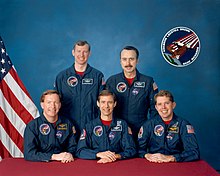STS-28

Liftoff of STS-28.
|
|
| Mission type | Satellite deployment |
|---|---|
| Operator | NASA |
| COSPAR ID | 1989-061A |
| SATCAT no. | 20164 |
| Mission duration | 5 days, 1 hour, 8 seconds |
| Distance travelled | 3,400,000 kilometres (2,100,000 mi) |
| Orbits completed | 81 |
| Spacecraft properties | |
| Spacecraft | Space Shuttle Columbia |
| Payload mass | 19,600 kilograms (43,200 lb) |
| Crew | |
| Crew size | 5 |
| Members |
Brewster H. Shaw, Jr. Richard N. Richards James C. Adamson David C. Leestma Mark N. Brown |
| Start of mission | |
| Launch date | 8 August 1989, 12:37:00 UTC |
| Launch site | Kennedy LC-39B |
| End of mission | |
| Landing date | 13 August 1989, 13:37:08 UTC |
| Landing site | Edwards Runway 17 |
| Orbital parameters | |
| Reference system | Geocentric |
| Regime | Low Earth |
| Perigee | 289 kilometers (180 mi) |
| Apogee | 306 kilometers (190 mi) |
| Inclination | 57.0 degrees |
| Period | 90.5 minutes |
 Left to right - Seated: Richards, Shaw, Leestma; Standing: Brown, Adamson |
|
STS-28 was the 30th NASA Space Shuttle mission, the fourth shuttle mission dedicated to United States Department of Defense purposes, and the eighth flight of Space Shuttle Columbia. The mission launched on 8 August 1989 and traveled 2.1 million miles during 81 orbits of the Earth, before landing on runway 17 of Edwards Air Force Base, California, on 13 August. STS-28 was also Columbia's first flight since January 1986, when it had flown STS-61-C, the mission directly preceding the Challenger disaster of STS-51-L. The mission details of STS-28 are classified, but the payload is widely believed to have been the first SDS-2 communications satellite. The altitude of the mission was between 295 kilometers (183 mi) and 307 kilometers (191 mi).
Space Shuttle Columbia (OV-102) lifted off from Pad 39-B, Launch Complex 39 at Kennedy Space Center, Florida, on 8 August 1989. The launch took place at 8:37 am EDT.
During STS-28, Columbia deployed two satellites: USA-40 and USA-41. Early reports speculated that STS-28's primary payload was an Advanced KH-11 photo-reconnaissance satellite. Later reports, and amateur satellite observations, suggest that USA-40 was instead a second-generation Satellite Data System relay, similar to those likely launched on STS-38 and STS-53. These satellites had the same bus design as the LEASAT satellites deployed on other shuttle missions, and were likely deployed in the same fashion.
...
Wikipedia

